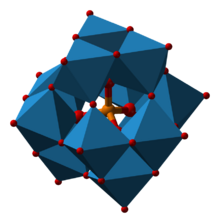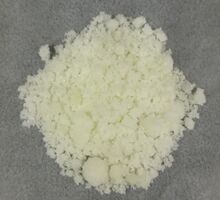Chemistry:Silicotungstic acid

| |

| |
| Names | |
|---|---|
| Other names
Tungstosilicic acid
| |
| Identifiers | |
| |
3D model (JSmol)
|
|
| ChemSpider | |
PubChem CID
|
|
| UNII |
|
| |
| |
| Properties | |
| H 4[SiW 12O 40] | |
| Molar mass | 2878.2 g/mol |
| Appearance | White solid |
| Melting point | 53 °C (127 °F; 326 K) |
| Structure | |
| zero | |
| Hazards | |
| GHS pictograms |  
|
| GHS Signal word | Danger |
| H314, H315, H319, H335, H412 | |
| P260, P261, P264, P271, P273, P280, P301+330+331, P302+352, P303+361+353, P304+340, P305+351+338, P310, P312, P321, P332+313, P337+313, P362, P363, P403+233, P405, P501 | |
| Flash point | Non-flammable |
| Related compounds | |
Related heteropoly acids
|
Phosphotungstic acid |
Related compounds
|
Tungsten trioxide Tungstic acid |
Except where otherwise noted, data are given for materials in their standard state (at 25 °C [77 °F], 100 kPa). | |
| Infobox references | |
Silicotungstic acid or tungstosilicic acid is a heteropoly acid with the chemical formula H
4[SiW
12O
40]. It forms hydrates H
4[SiW
12O
40] · nH
2O. In freshly prepared samples, n is approximately 29, but after prolonged desiccation, n = 6.[1] It is a white solid although impure samples appear yellow. It is used as a catalyst in the chemical industry.[2]
Applications
Silicotungstic acid is used to manufacture ethyl acetate by the alkylation of acetic acid by ethylene:
- C
2H
4 + CH
3CO
2H → CH
3CO
2C
2H
5
It has also been commercialized for the oxidation of ethylene to acetic acid:[2]
- C
2H
4 + O
2 → CH
3CO
2H
This route is claimed as a "greener" than methanol carbonylation. The heteropoly acid is dispersed on silica gel at 20-30 wt% to maximize catalytic ability.
It has also recently been proposed as a mediator in production of hydrogen through electrolysis of water by a process that would reduce the danger of explosion while allowing efficient hydrogen production at low current densities, conducive to hydrogen production using renewable energy.[3]
Synthesis and structure
The free acid is produced by combining sodium silicate and tungsten trioxide followed treatment of the mixture with hydrochloric acid.[1][4] The polyoxo cluster adopts a Keggin structure, with Td point group symmetry.
Hazards
Silicotungstic acid is an irritating and odorless substance.
References
- ↑ 1.0 1.1 Dias, J. A.; Dias, S. C. L.; Caliman, E. (2014). "Keggin Structure Polyoxometalates". Keggin Structure Polyoxoometalates. Inorganic Syntheses. 36. p. 210-217. doi:10.1002/9781118744994.ch39. ISBN 9781118744994.
- ↑ 2.0 2.1 Misono, Makoto (2009). "Recent progress in the practical applications of heteropolyacid and perovskite catalysts: Catalytic technology for the sustainable society". Catalysis Today 144 (3–4): 285–291. doi:10.1016/j.cattod.2008.10.054.
- ↑ Rausch, Benjamin; Symes, Mark D.; Chisholm, Greig; Cronin, Leroy (September 12, 2014). "Decoupled catalytic hydrogen evolution from a molecular metal oxide redox mediator in water splitting". Science (American Association for the Advancement of Science) 345 (6202): 1326–1330. doi:10.1126/science.1257443. PMID 25214625. Bibcode: 2014Sci...345.1326R.
- ↑ Handbook of Preparative Inorganic Chemistry, 2nd Ed. Edited by G. Brauer, Academic Press, 1963, NY.
 |
